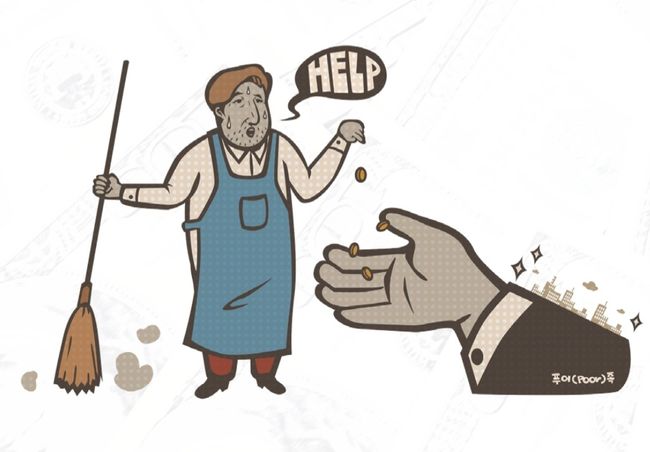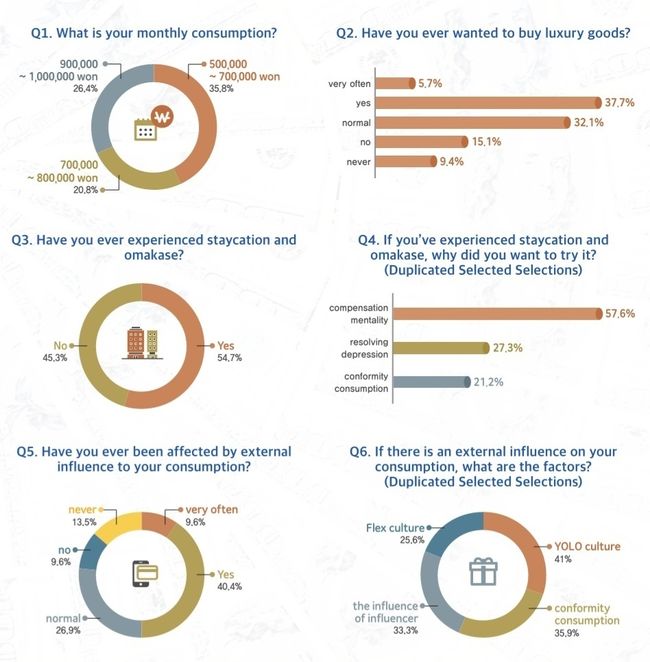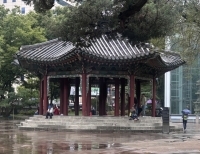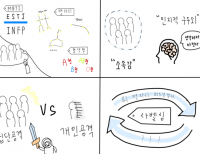These days, the MZ generation is familiar with ‘flex culture’ where people show off their consumption on SNS. Morgan Stanley, a global investment bank, said Korea’s per capita personal luxury spending of Korean ranks first in the world. Compared to last year, Korea’s personal luxury spending has increased by 24% to $16.8 billion, which is about $325 per person. This is also related to ‘YOLO culture’, in which young people pursue immediate gratification. This cultural consumption phenomenon invokes a spirit of sympathy. It seems that cultural consumption results in sympathetic consumption.

On the other hand, as mental illnesses and depression among in their 20s and 30s increase, there are many cases of consumption for the purpose of relieving depression. This is a form of emotional consumption, in which people obtain satisfaction by focusing on immediate short-term pleasure only for the purpose of relieving depression. This emotional consumption is also related to the compensation mentality that places a price on certain behaviors. Compensation mentality is a form of compensatory consumption, but the reality is that it is usually viewed negatively in society compared to its original meaning because this psychological phenomenon generates impulsive consumption. Then where did this psychological phenomenon come from? Pharos did a survey about consumption status and financial status of those in their 20s to reveal the reasons behind excessive consumption.
Pharos conducted a survey among 53 university students in their early and mid-20s and the average monthly consumption of the respondents was between 500,000 won and 1 million won. Regarding the question of consumption of luxury products in the survey, 34% of the respondents said that they have purchased luxury goods, and the number of luxury goods they owned is found minimum 1 to maximum 9. Additionally, to the question “Excluding electronic equipment, how expensive must something be to be considered a luxury goods?”, 49.1% of the respondents answered “over 500,000 won.” It should be noted that 500,000 won is not a small amount of money considering that their monthly consumption is 500,000 won to 1 million won. Nevertheless, when asked if they ever wanted to buy luxury goods, “Yes” accounted for the most common answer at 37.7%. Why do they want to buy luxury products even though they are on a tight budget?

Meanwhile, we asked people’s thoughts about staycation and omakase, both of which are popular among young people. 54.7% of the respondents said that they had experienced them already. Why did they experience staycation and omakase even though they are so expensive? In response, 57.6% of the respondents replied ‘compensation mentality’ and 27.3% said it was for ‘resolving depression.’ This result shows that consumption behavior was aimed at filling emotional deficiencies and relieving stress and depression from the outside rather than consuming to fill something that is necessary or objectively deficient. This emotional andcompensatory consumption seems to improve emotional discomfort by generating pleasure in the short term, but in the long run ultimately nothing is solved. Rather, if excessive, it can result in economic poverty and a more impoverished emotional state, so it is essential to control emotional and compensatory consumption well.
Next, when asked, “If there is an external influence on your consumption, what are the factors?” 41% of the respondents responded ‘YOLO culture’; 35.9% of the respondents answered ‘conformity consumption’ due to SNS; 33.3% of the respondents replied ‘the influence of influencer’; and 25.6% of the respondents stated ‘the social atmosphere where flex culture is prevalent.’ In particular, when asked “Have you ever been affected by external influence on your consumption?”, 40.4% of the respondents said “yes,” and 9.6% of the respondents said “very often.” This indicates that about half of the respondents are greatly affected by outward influences on their consumption. Therefore, let’s deal with emotional consumption, pent-up consumption, flex/YOLO, and conformity consumption in a concrete way in order to identify the consumption patterns of modern people and proper consumption habits.
Emotional Consumption
People often overspend to relieve depression, this kind of consumption is called emotional consumption. In other words, they get psychological relaxation through consumption behavior. Recently the extent of emotional consumption is getting so bad that 9 out of 10 adults pay for their feelings. However, is emotional consumption really effective in relieving stress? A survey by Findjob showed 52.3% of respondents answered that they feel better after emotional consumption, but they were soon again stressed about spending. Furthermore, 40.7% responded that stress was relieved, and 7% said it was not very helpful. (More Information : http://www.findjob.co.kr/main.asp)

The reason why emotional consumption causes problems is because of financial problems. If emotional consumption continues, one’s consumption cannot be controlled and it will lead to financial problems such as loans and credit card debt. It can relieve anxiety and calm one’s emotions temporarily, but in the long-term, it can also arouse another form of anxiety. Consequently, a vicious cycle of consumption continues. In addition, it can cause environmental problems, too. The increasing amount of indiscriminate consumption is directly related to environmental pollution problems along with the waste of resources for goods.In order to escape from emotional consumption, individual efforts are needed to overcome one’s consumption patterns. It is important to correctly understand the type of consumption and find alternatives to relieve unstable
emotional states instead of resorting to emotional consumption. Furthermore, it can be helpful to set our own consumption limits and make an effort to control our own consumption habits.
Pent-up Consumption
Pent-up consumption is a phenomenon where consumers try to fill unfulfilled desires by purchasing goods. This seems to be the most common type of consumption recorded on the survey organized by Pharos. Since COVID-19 restricts external activities, there is a tendency to resolve this desire. In turn, consumption has increased. The feature of pent-up consumption is irrational consumption behavior where people buy luxury items rather than daily necessities. The reason for this is depression. The lack of social networks and a feeling of helplessness stimulate a compensation mentality. It is dangerous behavior.
Dopamine is released when people feel pleasure through pent-up consumption, and this results in the brain looking forward to such behavior in the future. If this situation is repeated, it could lead to serious problems. People who become addicted to this type of consumption often overspend in spite of their financial state. When you feel like you are experiencing pent-up consumption, you have to reduce your exposure to incentives for consumption. You should restrain yourself from visiting online shopping malls, delete shopping applications, and pay attention to only buying necessities. Moreover, you should try to change what makes you feel happy. Taking up hobbies and exercising helps control your desire to consume.

Flex and YOLO
There is a desire to show off to other people. People “flex” expensive things to boast about their success or wealth. YOLO means “You only live once”, which emphasizes immediate happiness. Flex and YOLO are a bit out of fashion; however, this kind of consumption attitude is rampant. As the survey shows, the highest external influence that has an effect is the culture of YOLO. People’s tendency to pursue happiness through consumption is still an issue today. The reason why flex and YOLO are prevalent in society is future uncertainty. We often choose consumption that lets us feel pleasure right away rather than invest for an undefined future. It is natural to seek happiness in the present. Nonetheless, it is important to plan for future goals and build systematic consumption habits rather than overspending just to feel fleeting happiness.
Conformity Consumption
Most markets have been frozen since the COVID-19 outbreak, but there is only one industry that has been still hot: the luxury industry. What is the real reason that people want to buy luxury goods? Conformity consumption is the act of purchasing the same or similar product to imitate the purchasing behavior of others. People consume luxury goods to associate with others. Rather than just expressing themselves through luxury goods, consumers want to let people know that they belong to some group.

People compare their daily lives with influencers on social media. In the past, it was easy to see celebrities appear on TV and advertise products. Recently, however, it is more common to see influencers on social media such as Instagram and YouTube participate in advertisements and sponsorships. Unboxing videos showing new luxury goods for the first time, videos showcasing staycation, and reviews of omakase and luxury restaurants are some examples of this. Looking at the luxurious daily lives that influencers show off on SNS, regular people develop an inner desire to live like them. After they enter the stage of ‘conformity,’ they follow the consumption habits that influencers show on their SNS, which leads them to conformity consumption. However, simply choosing what to buy based on what other people consume easily leads to irrational purchases and impulsive consumption.
There are four main types of consumption that cause overconsumption, which have been specified above. First, emotional consumption repeats the vicious cycle of consumption and further causes environmental problems. Therefore, it is important to identify your emotional consumption type, identify what emotional situations make you spend impulsively, and find an alternative solution to unstable emotional states in order to replace emotional consumption. Second, pent-up consumption is highly addictive. This encourages irrational and impulsive overspending. For this reason, it is necessary to reduce exposure to social media, relieve depression and helplessness, and change what makes you happy. Third, people find happiness through flex and YOLO consumption. However, this type of consumption can also cause impulsive or excessive consumption, so people should find happiness through healthy consumption habits. Finally, people who do conformity consumption constantly compare themselves to the world on SNS. They should consume products according to the values that they pursue in their own lives rather than basing them on the lives of others.
Individual lifestyles deserve respect, and because we are human, we are bound to be influenced by the outside world. This external influence also has the advantage of allowing individuals to experience a wider world by giving them new inspiration and unexpected experiences. However, destructive consumption habits make you forget what your life’s priorities are. It is important to think deeply about whether your consumption habits are truly your own choice or based an external influence. Finally, not being subject to emotional consumption, pent-up consumption, flex/YOLO, and conformity consumption, and instead of trying to consume according to your own values by focusing on the essence of consumption, will be the first step to becoming a wise consumer. Currently Koreans’ personal luxury spending per capita is the highest in the world. It is time to look back on whether you are spending wisely.
77th Reporter • JOE YEON WOO • amyjoe0213@naver.com
78th Reporter • KIM DA ON • daonda0904@naver.com
79th Reporter • YUN SI O • ysbcindy1026@naver.com
 Freedom Given to Youth: An Opportunity for Choice or a Burden of Constraint?
“Are we truly free today?” Classical literature is far more than time-honored stories. It offers profound insights into human nature and society that transcend time, remaining a valuable resource for examining the challenges our world faces today. This article will draw on George Orwell’s 1984 and Charles Dickens’ Oliver Twist to explore the contemporary issues of youth housing and the emergence of a surveillance society ...
Freedom Given to Youth: An Opportunity for Choice or a Burden of Constraint?
“Are we truly free today?” Classical literature is far more than time-honored stories. It offers profound insights into human nature and society that transcend time, remaining a valuable resource for examining the challenges our world faces today. This article will draw on George Orwell’s 1984 and Charles Dickens’ Oliver Twist to explore the contemporary issues of youth housing and the emergence of a surveillance society ...

 [단신] 산악회, 본교 동문의 버팀목이 될 수 있도록
[단신] 산악회, 본교 동문의 버팀목이 될 수 있도록
 [사회메인] 노인 인구 1,000만 시대, 준비 없는 사회가 불안해
[사회메인] 노인 인구 1,000만 시대, 준비 없는 사회가 불안해
 [네컷만화] 라벨링 문화
[네컷만화] 라벨링 문화
 [진리터] 결국 우리 모두 돌아볼 것이니
[진리터] 결국 우리 모두 돌아볼 것이니

 목록
목록















